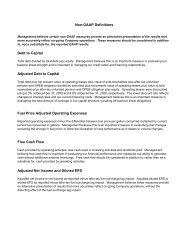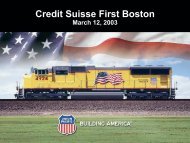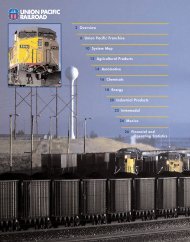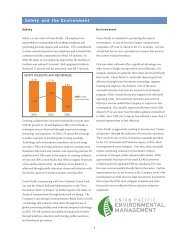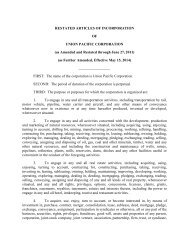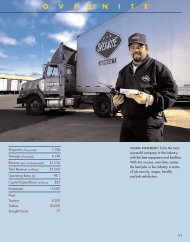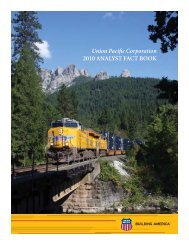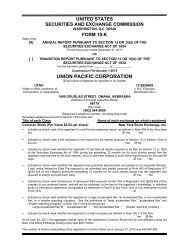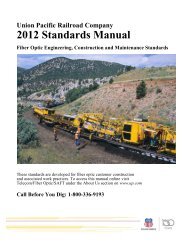You also want an ePaper? Increase the reach of your titles
YUMPU automatically turns print PDFs into web optimized ePapers that Google loves.
Industrial ProductsCommodity Profile<strong>2008</strong> CarloadsThe Railroad’s extensive network enables the Industrial Productsgroup to move numerous commodities between thousands ofshippers and customers throughout North America. In <strong>2008</strong>,Industrial Products provided 19 percent of <strong>Union</strong> Pacifi c’s totalfreight revenue.International 9%Mexico 8%Domestic 83%Lumber shipments originate primarily in the PNW and Canadafor destinations throughout the U.S. for new home constructionand repair and remodeling markets. Commercial and highwayconstruction drive shipments of steel and construction products,consisting of rock, cement and roofi ng. Shipments of paper andconsumer goods, including furniture and appliances, move tomajor metropolitan areas for consumers. Industrial manufacturingplants receive shipments of nonferrous metals and industrialminerals. In addition, the Railroad provides effi cient and safetransportation for government entities and waste companies.Demand is driven by macro-economic factors such as industrialproduction and housing starts. In <strong>2008</strong>, U.S. industrial productiondeclined 2 percent and housing starts fell 33 percent, contributingto a 6 percent decrease in carloads for the Industrial Productsgroup. Pricing actions and fuel surcharges increased averagerevenue per car growth by 13 percent for the year, more thanoffsetting volume declines. As a result, Industrial Products revenueincreased 6 percent in <strong>2008</strong>.Construction Products 34%Metals 22%Minerals/Consumer 13%Paper 12%Lumber 10%Government/Waste 9%Fewer housing starts, surplus production and general marketuncertainty drove weak lumber volumes in <strong>2008</strong>. Lumbercarloadings decreased by 26 percent and revenue fell by 15percent year-over-year.Steel and scrap steel carloadings increased 8 percent in <strong>2008</strong>versus 2007, due to domestic market strength. Specifi cally,international prices exceeded domestic, in part due to the weakU.S. dollar, and service centers restocked from low inventorylevels. Price increases and fuel surcharges drove a 22 percentrevenue increase year-over-year.Industrial Products Line Density MapSoft residential, commercial and highway construction reducedstone volume by 6 percent in <strong>2008</strong> versus 2007. However, priceincreases and fuel surcharges yielded a 4 percent increase in totalrevenue.Volumes of non-metallic minerals grew in <strong>2008</strong>. Increases innatural gas drilling activity presented business opportunities infracturing sand (frac sand) and barite, driving a 6 percent increasein non-metallic mineral volume. Price and fuel surcharges pushedaverage revenue per car up 15 percent, resulting in revenuegrowth of 21 percent.Lane density based on carloadings. Line thickness depicts traffi c density.23



